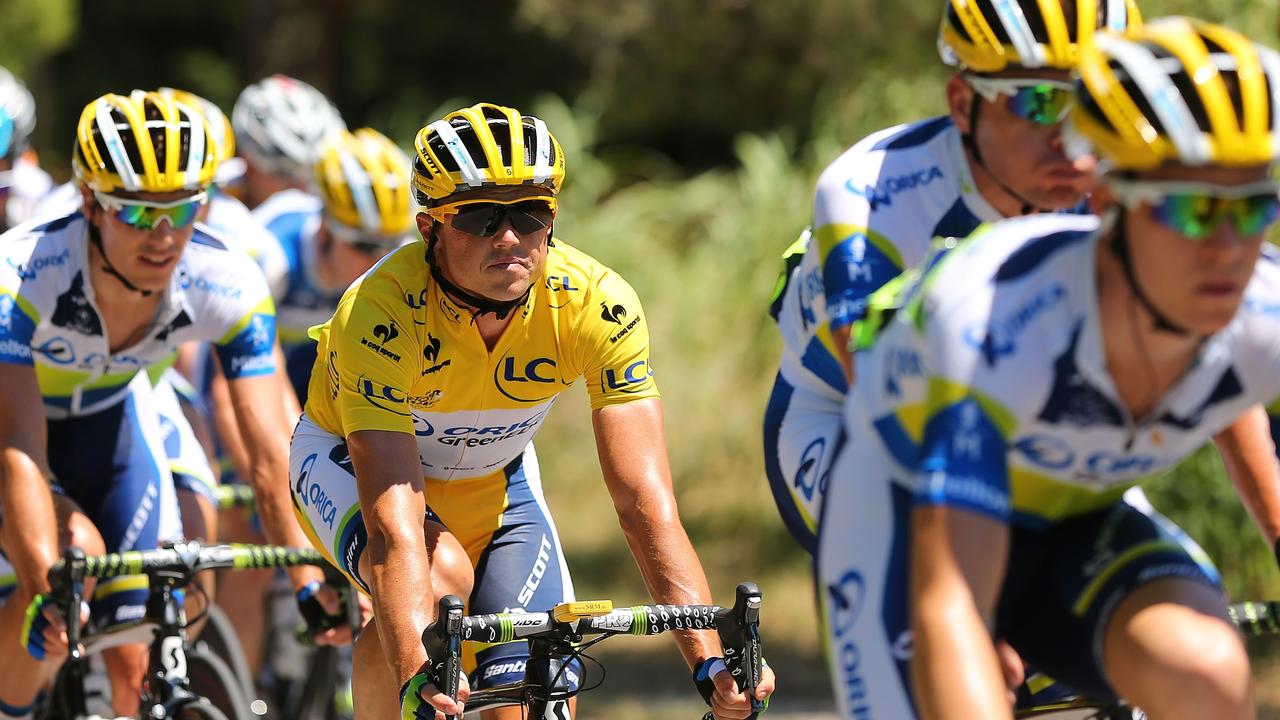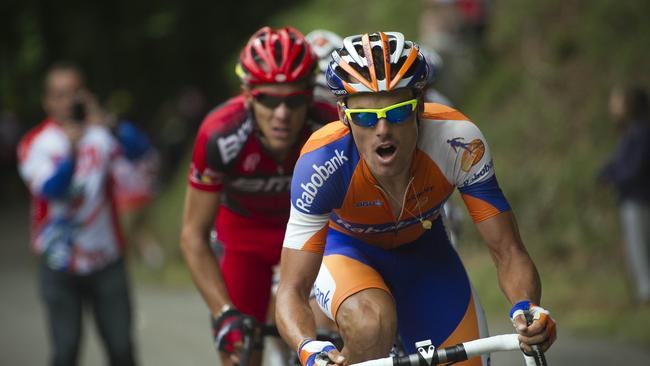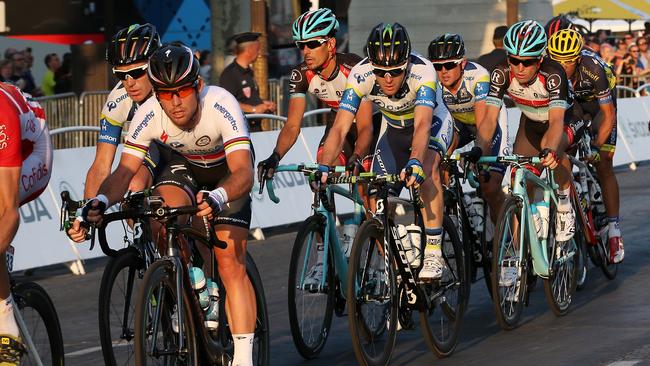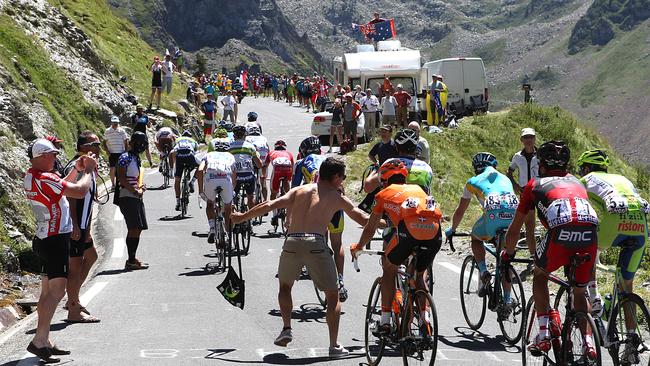Talking tactics and lingo at the Tour de France
SICK and tired of watching the Tour de France and having no idea what everyone’s saying? Here’s your guide to all the tactics and race lingo.

SICK and tired of watching the Tour de France and having no idea what everyone’s saying?
Here’s everything you’ll need to know about the race tactics, strange terms and jersey colours before sitting down to watch this year’s race.
Why and how does a breakaway form?
You’re a mad keen cycling fan, you sit down with a mate to watch the Tour de France one night in the hope that they’ll become a cycling fan, and the conversation goes something like this:
Q: Why are those riders 3 minutes ahead of everyone else?
A: That’s the breakaway.
Q: What’s a breakaway?
A: A group of riders who have either been allowed to get off the front or have sprinted ahead early in the stage.
Q: So one of them could win the Tour?
A: No, just the stage.
Q: Why would everyone let them get away like that?
A: Because if the peloton gets its calculations correct, they’ll catch them before the end of the stage.
Q: The whole thing seems a bit pointless then.
A: Yes, it does, but…..
Road cycling can seem so complex and hard to understand at times but really, when it all comes down to it, in a way it’s a bit like gambling.
A group of riders will attack at one point early in the race, build a lead and hope their gamble pays off and the peloton either doesn’t catch them before the finish or they launch a second counter-attack and go on to win the stage.

But winning the stage is only one motivating factor for a rider or a team wanting to get in the daily breakaway. If you’re a sprinter you might want to get in the breakaway to make sure you get points at the intermediate checkpoints during a stage which go towards the green jersey standings.
A lesser known team might simply want to get in the breakaway to get more TV coverage and airtime for their sponsors, or a rider might want to make a name for themselves for being a strong, attacking cyclist.
A team might also try to put one or more riders in a breakaway, knowing that later in the stage its team leader will leap from the main field, ride across to the breakaway and will want a teammate there.
So as you can see, forming a breakaway is like rolling the dice, like choosing red or black at the roulette table and if you come up trumps then you could be in for a massive payday.

Why is there a time cut?
The time cut is designed to make sure every rider works as hard as possible every day to make it to the finish. We can’t have a situation where riders targeting the yellow jersey go up Alpe d’Huez flat chat and the sprinters who simply want to sit tight until Paris amble up four hours later conserving energy.
So the time cut — after which any rider who finishes will be eliminated from the race — is calculated using the winners’ overall time and their average speed. Therefore the time cut could be the winners’ time plus a certain percentage — for example eight per cent.
It usually means a sprinter’s team will be doing quick calculations from the car to make sure their rider either gets a hurry on or can afford to take it easy over the last few kilometres.
Of course the time cut is still at the discretion of the race commissaires. On Stage 8 of the 2001 Tour de France, 14 riders in the breakaway finished a whopping 35 minutes ahead of the main field.
So if the rules were applied, there would have only been 14 men starting the Tour the following day. Thankfully, common sense was applied.
But the same luxury wasn’t afforded to American Ted King, who slipped off the back of Cannondale’s team time trial on Stage 4 in last year’s Tour de France, three days after a nasty crash in which he hurt his shoulder. He finished outside the 25 per cent time cut and was booted out of the race.
Why are some days more significant than others?
It doesn’t take much to motivate a cyclist during the Tour de France, particularly when they have something special to ride for.
Take the French every year on July 14 — Bastille Day, which is the English name for France’s national day.
We haven’t had a French winner at the Tour de France on Bastille Day since David Moncoutie in 2005 but you can bet your bottom dollar there’ll be a Frenchman in the breakaway every time.
This year Bastille Day falls on Stage 10, which is the 161km trip from Mulhouse to La Planche des Belles Filles, and with seven categorised climbs, the good news is it’s tailor made for a breakaway to stay away.
So just imagine if we had Thomas Voeckler in the breakaway this Bastille Day, head bobbing, face grimacing, body swaying all the way to the finish line.
Cycling fans can be hugely patriotic. Think about ‘Dutch corner’ on Alpe d’Huez every year, and if you were at the Tour Down Under in 2013 when Simon Gerrans won on top of Old Willunga Hill on Australia Day then you’ll never ever forget it.
This year the Tour de France begins in Leeds and the first three stages are in the UK so expect Mark Cavendish to be super motivated to win on home soil.
Why is a teammate in the mountains worth five on the flat?
Lone rangers don’t win the Tour de France, or at least not very often. There might be only one man in the yellow jersey and one man standing on top of the podium in Paris, but it takes an entire team to win the world’s greatest bike race.
And not surprisingly, you need them in the mountains. Teammates are super important on the flat — particularly big-bodied riders who can fight their way to the front of the peloton and take their leader with them to avoid the chaos and carnage of any crashes behind them.
But for a rider with GC ambitions, having a teammate by their side when the race gets hot in the mountains is invaluable. A leader can sit on their teammate’s wheel, conserve energy, let them chase down any attacks while being dragged along the whole time.
Having two riders from the same team still at the front of the race on the big climbs also puts every other team under pressure because providing they’re both high on GC, they’ve got multiple cards to play and it’s one more rider everyone else has to watch.
A domestique or teammate who can climb as well as their leader is invaluable. Think about the way Michael Rogers and Roman Kreuziger climbed with Albert Contador last year, or the way Richie Porte would drop Chris Froome at the top of the climb and let him do the rest.
Like it or not, the Tour de France is almost always decided in the mountains and sometimes it’s the strongest team — not necessarily always the strongest man — who wins.
TERMS YOU’LL HEAR WHILE WATCHING THE TOUR
‘Aero’
Shortened from ‘aerodynamic’, which is particularly important in the time trial when riders have no protection from the wind.
Example: “He’s getting really aero here, he’s got his aero bars, aero helmet and is in the perfect time trial position.”
‘Bidon’
A water bottle that sits neatly in a cage on the downtube of the bike.
Example: “He’s dropped a bidon and that could cause chaos for the bunch behind him if someone hits it with their wheel.”
‘Breakaway’
A group of riders (only has to be one or more) that has gone ahead of the main field on a stage.
Example: “The breakaway has got five minutes on the peloton containing yellow jersey Chris Froome with 45km remaining.”
‘Bonked’
When a rider is completely exhausted usually brought on by a sudden lack of energy because of a lack of food or water.
Example: “He’s bonked, he’s hit the wall, it’s all over, what an unfortunate way for his day to end.”
‘Bunch sprint’
When a mostly flat stage is decided by a large group of riders who are sprinting for line honours at the end.
Example: “It’s a pancake flat stage today, we’ll see a breakaway go up the road and the main field will bring it back together for a bunch sprint finish.”
‘Cadence’
The rate at which a cyclist can turn their pedals, which is usually measured in revolutions per minute.
Example: “Look at Christopher Froome’s high cadence as he flies up Alpe d’Huez and not a single rider can go with him.”
‘Domestique’
A workhorse or teammate dedicated to serving the team leader or sprinter.
Example: “And they’ve sent young Luke Durbridge back to the team car to fetch the water bottles for his teammates. Then he’ll get back on the front of the peloton to catch the breakaway.”

‘Drafting’
Sitting directly behind another rider to minimise wind drag.
Example: “He’s got the perfect sit behind big Jens Voigt, which is the ideal drafting position in these crosswinds.”
‘Echelon’
A line or group of riders strung out diagonally to avoid the affects of a crosswind.
Example: “And you’ll notice little echelons have started to form here, just like they did when Omega Pharma-Quickstep attacked on Stage 13 last year.”
‘Feed zone’
A designated area where team soigneurs can stand and hand out bags with food for the riders.
Example: “It’s going to be chaos in the feed zone today where more than 150 riders will come flying through at the same time, desperate not to allow any gaps to form.”
‘Gruppetto’
The final group on the road that unites together, particularly on a mountain stage, in a bid to make it to the finish inside the time cut.
Example: “Here comes the gruppetto being driven by Andre Greipel and Mark Cavendish as they climb Alpe d’Huez for the second time today.”
‘GC’
Short for General Classification, which is the overall standings in the Tour de France.
Example: “Christopher Froome retains his lead on GC while Alberto Contador has slipped to third after Stage 10.”

‘Hors Categorie’
Also known as HC, which represents the toughest climbs in the Tour de France — also known as beyond classification.
Example: “Greeting the riders today will be a Category 1 climb and two Hors Categorie climbs, which will stretch them to the limit.”
‘Lead out’
The technique whereby a rider or riders form a line with their sprinter at the end, then gradually increase the pace before peeling off allowing the last man in line to go for the win.
Example: “Lotto-Belisol are driving the front of the peloton with 1km to go and Andre Greipel sits fifth wheel and is about to get a perfect lead-out.”
‘Neo pro’
Rookie or first-year professional.
Example: “Young Australian Rohan Dennis is enjoying a remarkable neo-pro season, which has led to his debut in the Tour de France.”
‘Palmares’
The list of a riders’ results throughout their career.
Example: “Superstar Fabian Cancellara’s palmares includes three Paris-Roubaix and three Tour of Flanders titles.”
‘Parcours’
The route or course for the race.
Example: “It’s a tough parcours for Stage 5 with three cobbled sections and a long climb to the finish line.”
‘Peloton’
The main bunch or group of cyclists in the field, which usually contains the race leader.
Example: “The breakaway has three minutes on the peloton, which is slowly but surely increasing the pace to bring it back together for a bunch sprint.”
‘Soigneur’
A staff member who basically exists to serve the riders by doing everything from massage, to cooking, cleaning and transportation.
Example: “You can see the long line of soigneurs standing on the road at the feed zone handing out bags of food and drink bottles to the riders.”
‘Swing off’
When a rider has finished their turn on the front of the bunch, no matter how big or small, and they move wide to allow another rider to pass on the inside.
Example: “Richie Porte has finally decided enough is enough and it’s time to swing off after a gruelling effort in the mountains. it’s up to his team leader Christopher Froome to finish the job from here.”
‘Tempo’
A solid, steady pace being set by the rider or riders on the front of a group.
Example: “You can see Cannondale has gone to the front of the peloton and the riders are setting a nice tempo to catch the leaders so Peter Sagan can take aim at the stage victory.”
THE JERSEYS
Yellow: Worn by the leader of the general classification — the rider with the fastest cumulative time of the race.
2013 winner: Christopher Froome (Team Sky)
Green: Worn by the leader of the points classification. Also known as the sprinter’s jersey, with points awarded to riders in placing order at the finish and at intermediate checkpoints.
2013 winner: Peter Sagan (Cannondale)
White: Worn by the best-placed rider in the race who is under the age of 25 — also known as the young rider jersey.
2013 winner: Nairo Quintana (Movistar)
Polka dot: Worn by the leader of the mountains classification, in which riders are awarded points for being first to the top of major climbs on each stage.
2013 winner: Nairo Quintana (Movistar)
Originally published as Talking tactics and lingo at the Tour de France



